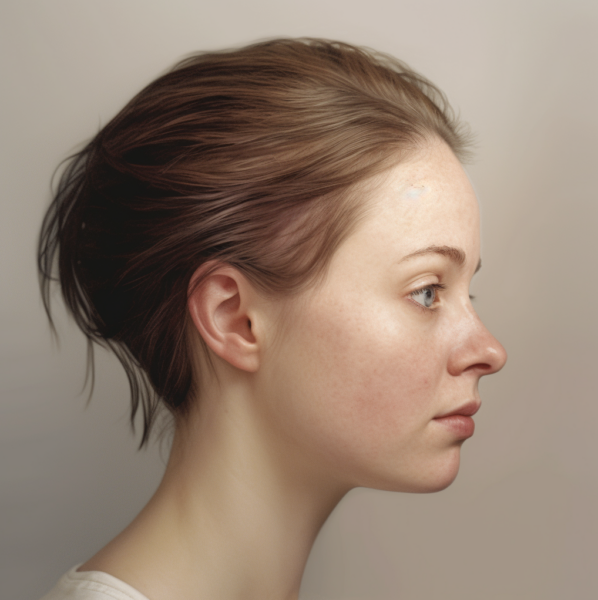Every day, we brush, style, and sometimes even color our hair without a second thought. But have you ever stopped to consider the science behind what’s happening to your hair? In this article, we are delving into the fascinating world of hair damage, specifically focusing on split ends.
Hair, a seemingly simple filament that grows from follicles found in the dermis, is a quite intricate structure with a complex biochemical composition. Each strand of scalp hair is composed of three layers: the medulla, the cortex, and the cuticle. The cuticle, the outermost layer, is a protective sheath made up of overlapping cells, similar to roof shingles. When this protective layer is compromised, it can lead to a common form of hair damage known as split ends, known scientifically as, trichoptilosis.
Trichoptilosis is a phenomenon that occurs when the protective cuticle is eroded from the end of the hair fibers. This erosion can be attributed to a multitude of factors, including but not limited to, excessive heat styling, chemical treatments, and environmental conditions such as UV radiation and wind exposure. Once the cuticle is damaged, the inner cortex, which is primarily composed of moisture-absorbing keratin proteins and melanin, is exposed, leading to further damage and splitting of the hair fiber.
How common are split ends? – very! One study that looked at the hair of 807 people close up using a magnifying device called a dermatoscope. The clinicians found many hair defects including split ends. Longitudinal cleavage of the hair (trichoptilosis) was found in 8% of people, both men and women, though it was usually most common in those with longer hair.
The science behind split ends is deeply rooted (slight pun intended!) in the biochemistry of hair. Hair is predominantly composed of a protein called keratin, which is characterized by the presence of a high proportion of cysteine residues capable of forming robust disulfide chemical bonds. These bonds provide strength and elasticity to the hair. However, when the hair undergoes physical or chemical stress, these disulfide bonds can be broken, leading to a compromised keratin structure, weakened hair, and eventually, the formation of split ends.
Interestingly, the morphology of the split end can provide insight into the type of damage the hair has undergone. For instance, a basic split end, which bifurcates into a “Y” shape, is the most common and is usually indicative of normal wear and tear. On the other hand, a feather split end, characterized by multiple splits along the hair shaft, is indicative of severe damage. Feather split ends are usually due to over use of chemical treatments or prolonged exposure to damaging factors such as over brushing and styling. Occasionally it can be an indication of a deficiency in essential nutrients.
Preventing split ends involves maintaining the integrity of the cuticle. This can be achieved through a balanced diet rich in proteins and essential fatty acids, regular trims to remove the damaged ends, and minimizing exposure to heat and harsh chemicals. The use of a wide-toothed comb instead of a brush can also help prevent mechanical damage to the cuticle.
In recent years, the field of cosmetic science has been exploring innovative solutions to tackle the issue of split ends. One such development is the use of specific polymers that can temporarily bind split ends together. These polymers, applied through certain hair care products, can provide a quick cosmetic fix for split ends, although they do not address the underlying hair damage.
Another promising area of research is the use of natural oils, such as coconut and argan oil, in hair care. These oils have been found to penetrate the hair shaft and provide some temporary stability to the structure, thereby strengthening the hair and potentially preventing the formation of split ends.
In conclusion, the science of split ends is a fascinating exploration of hair damage at a molecular level. It serves as a reminder that our hair, just like any other part of our body, requires care and attention. As we continue to advance in the field of cosmetic science, it is our hope that we can develop more effective strategies to combat hair damage and maintain the health and integrity of our hair. But for now, the next time you pick up that hairdryer or decide to skip your trim, remember the science behind split ends and make a choice that’s best for the health of your hair.
Bibliography
11711645 {11711645:DPK3MGZU},{11711645:QCEWTU5N},{11711645:EMHX8T3A},{11711645:9RB6BPXX},{11711645:3XTA2UG7},{11711645:88JK8M8J},{11711645:787UZ3M4},{11711645:ZMNGZGBH},{11711645:JZB5A3S8} 1 vancouver 50 date asc 112 https://www.keratin.com/wp-content/plugins/zotpress/ %7B%22status%22%3A%22success%22%2C%22updateneeded%22%3Afalse%2C%22instance%22%3Afalse%2C%22meta%22%3A%7B%22request_last%22%3A0%2C%22request_next%22%3A0%2C%22used_cache%22%3Atrue%7D%2C%22data%22%3A%5B%7B%22key%22%3A%2288JK8M8J%22%2C%22library%22%3A%7B%22id%22%3A11711645%7D%2C%22meta%22%3A%7B%22creatorSummary%22%3A%22Rele%20and%20Mohile%22%2C%22parsedDate%22%3A%222003%22%2C%22numChildren%22%3A0%7D%2C%22bib%22%3A%22%26lt%3Bdiv%20class%3D%26quot%3Bcsl-bib-body%26quot%3B%20style%3D%26quot%3Bline-height%3A%201.35%3B%20%26quot%3B%26gt%3B%5Cn%20%20%26lt%3Bdiv%20class%3D%26quot%3Bcsl-entry%26quot%3B%20style%3D%26quot%3Bclear%3A%20left%3B%20%26quot%3B%26gt%3B%5Cn%20%20%20%20%26lt%3Bdiv%20class%3D%26quot%3Bcsl-left-margin%26quot%3B%20style%3D%26quot%3Bfloat%3A%20left%3B%20padding-right%3A%200.5em%3B%20text-align%3A%20right%3B%20width%3A%201em%3B%26quot%3B%26gt%3B1.%26lt%3B%5C%2Fdiv%26gt%3B%26lt%3Bdiv%20class%3D%26quot%3Bcsl-right-inline%26quot%3B%20style%3D%26quot%3Bmargin%3A%200%20.4em%200%201.5em%3B%26quot%3B%26gt%3BRele%20AS%2C%20Mohile%20RB.%20Effect%20of%20mineral%20oil%2C%20sunflower%20oil%2C%20and%20coconut%20oil%20on%20prevention%20of%20hair%20damage.%20J%20Cosmet%20Sci.%202003%3B54%282%29%3A175%26%23x2013%3B92.%26lt%3B%5C%2Fdiv%26gt%3B%5Cn%20%20%20%26lt%3B%5C%2Fdiv%26gt%3B%5Cn%26lt%3B%5C%2Fdiv%26gt%3B%22%2C%22data%22%3A%7B%22itemType%22%3A%22journalArticle%22%2C%22title%22%3A%22Effect%20of%20mineral%20oil%2C%20sunflower%20oil%2C%20and%20coconut%20oil%20on%20prevention%20of%20hair%20damage%22%2C%22creators%22%3A%5B%7B%22creatorType%22%3A%22author%22%2C%22firstName%22%3A%22Aarti%20S.%22%2C%22lastName%22%3A%22Rele%22%7D%2C%7B%22creatorType%22%3A%22author%22%2C%22firstName%22%3A%22R.%20B.%22%2C%22lastName%22%3A%22Mohile%22%7D%5D%2C%22abstractNote%22%3A%22Previously%20published%20results%20showed%20that%20both%20in%20vitro%20and%20in%20vivo%20coconut%20oil%20%28CNO%29%20treatments%20prevented%20combing%20damage%20of%20various%20hair%20types.%20Using%20the%20same%20methodology%2C%20an%20attempt%20was%20made%20to%20study%20the%20properties%20of%20mineral%20oil%20and%20sunflower%20oil%20on%20hair.%20Mineral%20oil%20%28MO%29%20was%20selected%20because%20it%20is%20extensively%20used%20in%20hair%20oil%20formulations%20in%20India%2C%20because%20it%20is%20non-greasy%20in%20nature%2C%20and%20because%20it%20is%20cheaper%20than%20vegetable%20oils%20like%20coconut%20and%20sunflower%20oils.%20The%20study%20was%20extended%20to%20sunflower%20oil%20%28SFO%29%20because%20it%20is%20the%20second%20most%20utilized%20base%20oil%20in%20the%20hair%20oil%20industry%20on%20account%20of%20its%20non-freezing%20property%20and%20its%20odorlessness%20at%20ambient%20temperature.%20As%20the%20aim%20was%20to%20cover%20different%20treatments%2C%20and%20the%20effect%20of%20these%20treatments%20on%20various%20hair%20types%20using%20the%20above%20oils%2C%20the%20number%20of%20experiments%20to%20be%20conducted%20was%20a%20very%20high%20number%20and%20a%20technique%20termed%20as%20the%20Taguchi%20Design%20of%20Experimentation%20was%20used.%20The%20findings%20clearly%20indicate%20the%20strong%20impact%20that%20coconut%20oil%20application%20has%20to%20hair%20as%20compared%20to%20application%20of%20both%20sunflower%20and%20mineral%20oils.%20Among%20three%20oils%2C%20coconut%20oil%20was%20the%20only%20oil%20found%20to%20reduce%20the%20protein%20loss%20remarkably%20for%20both%20undamaged%20and%20damaged%20hair%20when%20used%20as%20a%20pre-wash%20and%20post-wash%20grooming%20product.%20Both%20sunflower%20and%20mineral%20oils%20do%20not%20help%20at%20all%20in%20reducing%20the%20protein%20loss%20from%20hair.%20This%20difference%20in%20results%20could%20arise%20from%20the%20composition%20of%20each%20of%20these%20oils.%20Coconut%20oil%2C%20being%20a%20triglyceride%20of%20lauric%20acid%20%28principal%20fatty%20acid%29%2C%20has%20a%20high%20affinity%20for%20hair%20proteins%20and%2C%20because%20of%20its%20low%20molecular%20weight%20and%20straight%20linear%20chain%2C%20is%20able%20to%20penetrate%20inside%20the%20hair%20shaft.%20Mineral%20oil%2C%20being%20a%20hydrocarbon%2C%20has%20no%20affinity%20for%20proteins%20and%20therefore%20is%20not%20able%20to%20penetrate%20and%20yield%20better%20results.%20In%20the%20case%20of%20sunflower%20oil%2C%20although%20it%20is%20a%20triglyceride%20of%20linoleic%20acid%2C%20because%20of%20its%20bulky%20structure%20due%20to%20the%20presence%20of%20double%20bonds%2C%20it%20does%20not%20penetrate%20the%20fiber%2C%20consequently%20resulting%20in%20no%20favorable%20impact%20on%20protein%20loss.%22%2C%22date%22%3A%222003%22%2C%22language%22%3A%22eng%22%2C%22DOI%22%3A%22%22%2C%22ISSN%22%3A%221525-7886%22%2C%22url%22%3A%22%22%2C%22collections%22%3A%5B%225EEQ884B%22%5D%2C%22dateModified%22%3A%222023-05-17T21%3A20%3A43Z%22%7D%7D%2C%7B%22key%22%3A%22ZMNGZGBH%22%2C%22library%22%3A%7B%22id%22%3A11711645%7D%2C%22meta%22%3A%7B%22creatorSummary%22%3A%22Trueb%22%2C%22parsedDate%22%3A%222005%22%2C%22numChildren%22%3A0%7D%2C%22bib%22%3A%22%26lt%3Bdiv%20class%3D%26quot%3Bcsl-bib-body%26quot%3B%20style%3D%26quot%3Bline-height%3A%201.35%3B%20%26quot%3B%26gt%3B%5Cn%20%20%26lt%3Bdiv%20class%3D%26quot%3Bcsl-entry%26quot%3B%20style%3D%26quot%3Bclear%3A%20left%3B%20%26quot%3B%26gt%3B%5Cn%20%20%20%20%26lt%3Bdiv%20class%3D%26quot%3Bcsl-left-margin%26quot%3B%20style%3D%26quot%3Bfloat%3A%20left%3B%20padding-right%3A%200.5em%3B%20text-align%3A%20right%3B%20width%3A%201em%3B%26quot%3B%26gt%3B1.%26lt%3B%5C%2Fdiv%26gt%3B%26lt%3Bdiv%20class%3D%26quot%3Bcsl-right-inline%26quot%3B%20style%3D%26quot%3Bmargin%3A%200%20.4em%200%201.5em%3B%26quot%3B%26gt%3BTrueb%20RM.%20Aging%20of%20hair.%20J%20Cosmet%20Dermat.%202005%3B4%282%29%3A60%26%23x2013%3B72.%26lt%3B%5C%2Fdiv%26gt%3B%5Cn%20%20%20%26lt%3B%5C%2Fdiv%26gt%3B%5Cn%26lt%3B%5C%2Fdiv%26gt%3B%22%2C%22data%22%3A%7B%22itemType%22%3A%22journalArticle%22%2C%22title%22%3A%22Aging%20of%20hair%22%2C%22creators%22%3A%5B%7B%22creatorType%22%3A%22author%22%2C%22firstName%22%3A%22Ralph%20M%22%2C%22lastName%22%3A%22Trueb%22%7D%5D%2C%22abstractNote%22%3A%22%22%2C%22date%22%3A%2206%5C%2F2005%22%2C%22language%22%3A%22en%22%2C%22DOI%22%3A%2210.1111%5C%2Fj.1473-2165.2005.40203.x%22%2C%22ISSN%22%3A%221473-2130%2C%201473-2165%22%2C%22url%22%3A%22%22%2C%22collections%22%3A%5B%225EEQ884B%22%5D%2C%22dateModified%22%3A%222023-05-17T21%3A22%3A05Z%22%7D%7D%2C%7B%22key%22%3A%229RB6BPXX%22%2C%22library%22%3A%7B%22id%22%3A11711645%7D%2C%22meta%22%3A%7B%22creatorSummary%22%3A%22Rigoletto%20et%20al.%22%2C%22parsedDate%22%3A%222007%22%2C%22numChildren%22%3A0%7D%2C%22bib%22%3A%22%26lt%3Bdiv%20class%3D%26quot%3Bcsl-bib-body%26quot%3B%20style%3D%26quot%3Bline-height%3A%201.35%3B%20%26quot%3B%26gt%3B%5Cn%20%20%26lt%3Bdiv%20class%3D%26quot%3Bcsl-entry%26quot%3B%20style%3D%26quot%3Bclear%3A%20left%3B%20%26quot%3B%26gt%3B%5Cn%20%20%20%20%26lt%3Bdiv%20class%3D%26quot%3Bcsl-left-margin%26quot%3B%20style%3D%26quot%3Bfloat%3A%20left%3B%20padding-right%3A%200.5em%3B%20text-align%3A%20right%3B%20width%3A%201em%3B%26quot%3B%26gt%3B1.%26lt%3B%5C%2Fdiv%26gt%3B%26lt%3Bdiv%20class%3D%26quot%3Bcsl-right-inline%26quot%3B%20style%3D%26quot%3Bmargin%3A%200%20.4em%200%201.5em%3B%26quot%3B%26gt%3BRigoletto%20R%2C%20Zhou%20Y%2C%20Foltis%20L.%20Semi-permanent%20split%20end%20mending%20with%20a%20polyelectrolyte%20complex.%20J%20Cosmet%20Sci.%202007%3B58%284%29%3A451%26%23x2013%3B76.%26lt%3B%5C%2Fdiv%26gt%3B%5Cn%20%20%20%26lt%3B%5C%2Fdiv%26gt%3B%5Cn%26lt%3B%5C%2Fdiv%26gt%3B%22%2C%22data%22%3A%7B%22itemType%22%3A%22journalArticle%22%2C%22title%22%3A%22Semi-permanent%20split%20end%20mending%20with%20a%20polyelectrolyte%20complex%22%2C%22creators%22%3A%5B%7B%22creatorType%22%3A%22author%22%2C%22firstName%22%3A%22R.%22%2C%22lastName%22%3A%22Rigoletto%22%7D%2C%7B%22creatorType%22%3A%22author%22%2C%22firstName%22%3A%22Y.%22%2C%22lastName%22%3A%22Zhou%22%7D%2C%7B%22creatorType%22%3A%22author%22%2C%22firstName%22%3A%22L.%22%2C%22lastName%22%3A%22Foltis%22%7D%5D%2C%22abstractNote%22%3A%22Split%20ends%20form%20through%20mechanical%20stresses%20during%20grooming%20procedures%20and%20are%20more%20likely%20to%20appear%20in%20hair%20damaged%20as%20a%20result%20of%20excessive%20combing%20forces.%20Although%20there%20are%20no%20conventional%20systems%20that%20will%20permanently%20mend%20split%20ends%2C%20a%20semi-permanent%20mending%20composition%20has%20been%20achieved%20through%20a%20polyelectrolyte%20complex.%20The%20complex%20is%20formed%20as%20a%20result%20of%20the%20ionic%20association%20of%20a%20cationic%20polymer%2C%20Polyquaternium-28%2C%20and%20an%20anionic%20polymer%2C%20PVM%5C%2FMA%20Copolymer.%20Hair%20tresses%20containing%20tagged%20split%20ends%20are%20used%20in%20measuring%20mending%20efficacy.%20The%20tagging%20allows%20the%20fate%20of%20the%20split%20ends%20to%20be%20determined%20after%20different%20types%20of%20treatment%20regimens%20which%20test%20the%20durability%20of%20the%20mend.%20Monitoring%20of%20the%20repair%20and%20mending%20durability%20is%20carried%20out%20with%20the%20aid%20of%20a%20stereomicroscope.%20Results%20obtained%20with%20this%20method%20indicate%20that%20the%20complex%20both%20by%20itself%20and%20when%20formulated%20into%20a%20simple%20lotion%20provided%20a%20high%20level%20of%20split%20end%20mending%20not%20only%20after%20initial%20treatment%20but%20more%20importantly%20after%20combing%20showing%20the%20durability%20of%20the%20mend.%20Cumulative%20effects%20and%20durability%20to%20washing%20indicate%20that%20the%20polymer%20complex%20does%20not%20build%20up%20on%20the%20hair%20and%20rinses%20off%20with%20shampoo%20making%20possible%20its%20usage%20as%20a%20post%20shampoo%20treatment.%20The%20formulated%20lotion%20has%20higher%20durability%20performance%20as%20compared%20to%20a%20commercial%20product%20with%20a%20split%20end%20mending%20claim.%20The%20proposed%20mechanism%20of%20action%20entails%20a%20crosslinking%20microgel%20structure%20that%20infiltrates%20the%20damaged%20hair%20sites%20binding%20them%20together.%20This%20model%20is%20supported%20by%20the%20analysis%20of%20phase%20behavior%2C%20viscometry%2C%20Scanning%20Electron%20Microscopy%2C%20and%20absorption%20of%20ionic%20dyes.%22%2C%22date%22%3A%222007%22%2C%22language%22%3A%22eng%22%2C%22DOI%22%3A%22%22%2C%22ISSN%22%3A%221525-7886%22%2C%22url%22%3A%22%22%2C%22collections%22%3A%5B%225EEQ884B%22%5D%2C%22dateModified%22%3A%222023-05-17T21%3A15%3A41Z%22%7D%7D%2C%7B%22key%22%3A%22EMHX8T3A%22%2C%22library%22%3A%7B%22id%22%3A11711645%7D%2C%22meta%22%3A%7B%22creatorSummary%22%3A%22Sinclair%22%2C%22parsedDate%22%3A%222007-12%22%2C%22numChildren%22%3A0%7D%2C%22bib%22%3A%22%26lt%3Bdiv%20class%3D%26quot%3Bcsl-bib-body%26quot%3B%20style%3D%26quot%3Bline-height%3A%201.35%3B%20%26quot%3B%26gt%3B%5Cn%20%20%26lt%3Bdiv%20class%3D%26quot%3Bcsl-entry%26quot%3B%20style%3D%26quot%3Bclear%3A%20left%3B%20%26quot%3B%26gt%3B%5Cn%20%20%20%20%26lt%3Bdiv%20class%3D%26quot%3Bcsl-left-margin%26quot%3B%20style%3D%26quot%3Bfloat%3A%20left%3B%20padding-right%3A%200.5em%3B%20text-align%3A%20right%3B%20width%3A%201em%3B%26quot%3B%26gt%3B1.%26lt%3B%5C%2Fdiv%26gt%3B%26lt%3Bdiv%20class%3D%26quot%3Bcsl-right-inline%26quot%3B%20style%3D%26quot%3Bmargin%3A%200%20.4em%200%201.5em%3B%26quot%3B%26gt%3BSinclair%20RD.%20Healthy%20hair%3A%20what%20is%20it%3F%20J%20Investig%20Dermatol%20Symp%20Proc.%202007%20Dec%3B12%282%29%3A2%26%23x2013%3B5.%26lt%3B%5C%2Fdiv%26gt%3B%5Cn%20%20%20%26lt%3B%5C%2Fdiv%26gt%3B%5Cn%26lt%3B%5C%2Fdiv%26gt%3B%22%2C%22data%22%3A%7B%22itemType%22%3A%22journalArticle%22%2C%22title%22%3A%22Healthy%20hair%3A%20what%20is%20it%3F%22%2C%22creators%22%3A%5B%7B%22creatorType%22%3A%22author%22%2C%22firstName%22%3A%22Rodney%20D.%22%2C%22lastName%22%3A%22Sinclair%22%7D%5D%2C%22abstractNote%22%3A%22Shiny%20hair%20with%20a%20smooth%20texture%20and%20clean-cut%20ends%20or%20tapered%20tips%20is%20generally%20perceived%20to%20be%20healthy.%20Hair%20texture%20and%20shine%20relate%20to%20hair%20surface%20properties%2C%20whereas%20the%20integrity%20of%20hair%20ends%20relates%20to%20the%20hair%20cortex.%20Hair%20can%20be%20straight%2C%20wavy%20or%20curly%2C%20blonde%2C%20black%2C%20brown%2C%20red%2C%20gray%20white%2C%20and%20its%20natural%20variations%20are%20important%20to%20our%20identity.%20Manipulation%20of%20the%20normal%20structure%20of%20the%20hair%20shaft%20is%20epidemic%20and%20dictated%20by%20culture%2C%20fashion%2C%20and%20above%20all%2C%20celebrity.%20Although%20cosmetic%20procedures%20are%20intrinsically%20safe%2C%20there%20is%20potential%20for%20damage%20to%20the%20hair.%20Loss%20of%20lustre%2C%20frizz%2C%20split%20ends%2C%20and%20other%20hair%20problems%20are%20particularly%20prevalent%20among%20people%20who%20repeatedly%20alter%20the%20natural%20style%20of%20their%20hair%20or%20among%20people%20with%20hair%20that%20is%20intrinsically%20weak.%20This%20may%20be%20due%20to%20individual%20or%20racial%20variation%20or%20less%20commonly%20an%20inherited%20structural%20abnormality%20in%20hair%20fiber%20formation.%20Hair%20health%20is%20also%20affected%20by%20common%20afflictions%20of%20the%20scalp%20as%20well%20as%20age-related%20phenomena%20such%20as%20graying%20and%20androgenetic%20alopecia.%20Hair%20products%20that%20improve%20the%20structural%20integrity%20of%20hair%20fibers%20and%20increase%20tensile%20strength%20are%20available%2C%20as%20are%20products%20that%20increase%20hair%20volume%2C%20reduce%20frizz%2C%20improve%20hair%20manageability%2C%20and%20stimulate%20new%20hair%20growth.%22%2C%22date%22%3A%222007-12%22%2C%22language%22%3A%22eng%22%2C%22DOI%22%3A%2210.1038%5C%2Fsj.jidsymp.5650046%22%2C%22ISSN%22%3A%221087-0024%22%2C%22url%22%3A%22%22%2C%22collections%22%3A%5B%225EEQ884B%22%5D%2C%22dateModified%22%3A%222023-05-17T21%3A08%3A52Z%22%7D%7D%2C%7B%22key%22%3A%22DPK3MGZU%22%2C%22library%22%3A%7B%22id%22%3A11711645%7D%2C%22meta%22%3A%7B%22creatorSummary%22%3A%22Haake%20et%20al.%22%2C%22parsedDate%22%3A%222009%22%2C%22numChildren%22%3A0%7D%2C%22bib%22%3A%22%26lt%3Bdiv%20class%3D%26quot%3Bcsl-bib-body%26quot%3B%20style%3D%26quot%3Bline-height%3A%201.35%3B%20%26quot%3B%26gt%3B%5Cn%20%20%26lt%3Bdiv%20class%3D%26quot%3Bcsl-entry%26quot%3B%20style%3D%26quot%3Bclear%3A%20left%3B%20%26quot%3B%26gt%3B%5Cn%20%20%20%20%26lt%3Bdiv%20class%3D%26quot%3Bcsl-left-margin%26quot%3B%20style%3D%26quot%3Bfloat%3A%20left%3B%20padding-right%3A%200.5em%3B%20text-align%3A%20right%3B%20width%3A%201em%3B%26quot%3B%26gt%3B1.%26lt%3B%5C%2Fdiv%26gt%3B%26lt%3Bdiv%20class%3D%26quot%3Bcsl-right-inline%26quot%3B%20style%3D%26quot%3Bmargin%3A%200%20.4em%200%201.5em%3B%26quot%3B%26gt%3BHaake%20HM%2C%20Marten%20S%2C%20Seipel%20W%2C%20Eisfeld%20W.%20Hair%20breakage--how%20to%20measure%20and%20counteract.%20J%20Cosmet%20Sci.%202009%3B60%282%29%3A143%26%23x2013%3B51.%26lt%3B%5C%2Fdiv%26gt%3B%5Cn%20%20%20%26lt%3B%5C%2Fdiv%26gt%3B%5Cn%26lt%3B%5C%2Fdiv%26gt%3B%22%2C%22data%22%3A%7B%22itemType%22%3A%22journalArticle%22%2C%22title%22%3A%22Hair%20breakage--how%20to%20measure%20and%20counteract%22%2C%22creators%22%3A%5B%7B%22creatorType%22%3A%22author%22%2C%22firstName%22%3A%22Hans-Martin%22%2C%22lastName%22%3A%22Haake%22%7D%2C%7B%22creatorType%22%3A%22author%22%2C%22firstName%22%3A%22Sandra%22%2C%22lastName%22%3A%22Marten%22%7D%2C%7B%22creatorType%22%3A%22author%22%2C%22firstName%22%3A%22Werner%22%2C%22lastName%22%3A%22Seipel%22%7D%2C%7B%22creatorType%22%3A%22author%22%2C%22firstName%22%3A%22Wolf%22%2C%22lastName%22%3A%22Eisfeld%22%7D%5D%2C%22abstractNote%22%3A%22A%20system%20to%20determine%20the%20efficacy%20of%20hair%20treatments%20in%20terms%20of%20anti-breakage%20and%20split%20end%20prevention%20was%20developed%20which%20involves%20the%20repeated%20combing%20of%20hair%20strands.%20The%20device%20allows%20ten%20hair%20strands%20to%20be%20combed%20simultaneously.%20First%2C%20the%20influences%20of%20chemical%20hair%20treatments%20like%20bleaching%20on%20hair%20breakage%20were%20examined.%20In%20a%20next%20step%2C%20the%20protective%20effects%20of%20benchmark%20products%20from%20the%20market%20were%20studied.%20Since%20nearly%20all%20commercial%20products%20with%20anti-breakage%20claims%20contain%20silicones%20combined%20with%20cationic%20polymers%2C%20alternative%20actives%20were%20searched.%20In%20a%20test%20series%20with%20different%20waxes%20in%20shampoo%20formulations%20with%20a%20variable%20number%20of%20parameters%2C%20the%20particle%20size%20was%20found%20to%20be%20the%20factor%20with%20the%20strongest%20influence%20on%20the%20amount%20of%20wax%20deposited%20on%20the%20shampooed%20hair.%20Therefore%2C%20a%20targeted%20development%20was%20started%2C%20resulting%20in%20a%20combination%20of%20several%20ethers%20dispersed%20in%20sodium%20laureth%20sulfate.%20Excellent%20conditioning%2C%20anti-breakage%20and%20split%20ends%20protection%20properties%20of%20the%20compound%20were%20found%2C%20showing%20also%20a%20dosage%20dependency.%20The%20latter%20could%20be%20explained%20by%20analyzing%20the%20amounts%20of%20waxes%20applied%20on%20treated%20hair.%20In%20these%20experiments%2C%20a%20dependency%20on%20the%20concentration%20in%20the%20shampoo%20was%20found.%22%2C%22date%22%3A%222009%22%2C%22language%22%3A%22eng%22%2C%22DOI%22%3A%22%22%2C%22ISSN%22%3A%221525-7886%22%2C%22url%22%3A%22%22%2C%22collections%22%3A%5B%225EEQ884B%22%5D%2C%22dateModified%22%3A%222023-05-17T21%3A15%3A00Z%22%7D%7D%2C%7B%22key%22%3A%22787UZ3M4%22%2C%22library%22%3A%7B%22id%22%3A11711645%7D%2C%22meta%22%3A%7B%22creatorSummary%22%3A%22Draelos%22%2C%22parsedDate%22%3A%222010-01%22%2C%22numChildren%22%3A0%7D%2C%22bib%22%3A%22%26lt%3Bdiv%20class%3D%26quot%3Bcsl-bib-body%26quot%3B%20style%3D%26quot%3Bline-height%3A%201.35%3B%20%26quot%3B%26gt%3B%5Cn%20%20%26lt%3Bdiv%20class%3D%26quot%3Bcsl-entry%26quot%3B%20style%3D%26quot%3Bclear%3A%20left%3B%20%26quot%3B%26gt%3B%5Cn%20%20%20%20%26lt%3Bdiv%20class%3D%26quot%3Bcsl-left-margin%26quot%3B%20style%3D%26quot%3Bfloat%3A%20left%3B%20padding-right%3A%200.5em%3B%20text-align%3A%20right%3B%20width%3A%201em%3B%26quot%3B%26gt%3B1.%26lt%3B%5C%2Fdiv%26gt%3B%26lt%3Bdiv%20class%3D%26quot%3Bcsl-right-inline%26quot%3B%20style%3D%26quot%3Bmargin%3A%200%20.4em%200%201.5em%3B%26quot%3B%26gt%3BDraelos%20ZD.%20Essentials%20of%20Hair%20Care%20often%20Neglected%3A%20Hair%20Cleansing.%20Int%20J%20Trichology.%202010%20Jan%3B2%281%29%3A24%26%23x2013%3B9.%26lt%3B%5C%2Fdiv%26gt%3B%5Cn%20%20%20%26lt%3B%5C%2Fdiv%26gt%3B%5Cn%26lt%3B%5C%2Fdiv%26gt%3B%22%2C%22data%22%3A%7B%22itemType%22%3A%22journalArticle%22%2C%22title%22%3A%22Essentials%20of%20Hair%20Care%20often%20Neglected%3A%20Hair%20Cleansing%22%2C%22creators%22%3A%5B%7B%22creatorType%22%3A%22author%22%2C%22firstName%22%3A%22Zoe%20D.%22%2C%22lastName%22%3A%22Draelos%22%7D%5D%2C%22abstractNote%22%3A%22Why%20does%20the%20selection%20of%20hair%20cleansing%20products%20and%20conditioners%20seem%20complex%3F%20Why%20are%20there%20clear%2C%20opalescent%2C%20green%2C%20blue%2C%20glittery%2C%20cheap%2C%20expensive%2C%20thick%2C%20thin%2C%20fragrant%2C%20and%20unscented%20varieties%20of%20shampoos%20and%20conditioners%3F%20Why%20the%20whole%20cleansing%20process%20cannot%20be%20simplified%20by%20using%20the%20same%20bar%20soap%20used%20on%20the%20body%20for%20the%20hair%3F%20Does%20the%20shampoo%20selected%20really%20make%20a%20difference%3F%20What%20can%20a%20conditioner%20accomplish%3F%22%2C%22date%22%3A%222010-01%22%2C%22language%22%3A%22eng%22%2C%22DOI%22%3A%2210.4103%5C%2F0974-7753.66909%22%2C%22ISSN%22%3A%220974-9241%22%2C%22url%22%3A%22%22%2C%22collections%22%3A%5B%225EEQ884B%22%5D%2C%22dateModified%22%3A%222023-05-17T21%3A21%3A03Z%22%7D%7D%2C%7B%22key%22%3A%22JZB5A3S8%22%2C%22library%22%3A%7B%22id%22%3A11711645%7D%2C%22meta%22%3A%7B%22creatorSummary%22%3A%22Robbins%22%2C%22parsedDate%22%3A%222012-02-25%22%2C%22numChildren%22%3A0%7D%2C%22bib%22%3A%22%26lt%3Bdiv%20class%3D%26quot%3Bcsl-bib-body%26quot%3B%20style%3D%26quot%3Bline-height%3A%201.35%3B%20%26quot%3B%26gt%3B%5Cn%20%20%26lt%3Bdiv%20class%3D%26quot%3Bcsl-entry%26quot%3B%20style%3D%26quot%3Bclear%3A%20left%3B%20%26quot%3B%26gt%3B%5Cn%20%20%20%20%26lt%3Bdiv%20class%3D%26quot%3Bcsl-left-margin%26quot%3B%20style%3D%26quot%3Bfloat%3A%20left%3B%20padding-right%3A%200.5em%3B%20text-align%3A%20right%3B%20width%3A%201em%3B%26quot%3B%26gt%3B1.%26lt%3B%5C%2Fdiv%26gt%3B%26lt%3Bdiv%20class%3D%26quot%3Bcsl-right-inline%26quot%3B%20style%3D%26quot%3Bmargin%3A%200%20.4em%200%201.5em%3B%26quot%3B%26gt%3BRobbins%20CR.%20Chemical%20and%20Physical%20Behavior%20of%20Human%20Hair.%20Springer%20Science%20%26amp%3B%20Business%20Media%3B%202012.%20746%20p.%26lt%3B%5C%2Fdiv%26gt%3B%5Cn%20%20%20%26lt%3B%5C%2Fdiv%26gt%3B%5Cn%26lt%3B%5C%2Fdiv%26gt%3B%22%2C%22data%22%3A%7B%22itemType%22%3A%22book%22%2C%22title%22%3A%22Chemical%20and%20Physical%20Behavior%20of%20Human%20Hair%22%2C%22creators%22%3A%5B%7B%22creatorType%22%3A%22author%22%2C%22firstName%22%3A%22Clarence%20R.%22%2C%22lastName%22%3A%22Robbins%22%7D%5D%2C%22abstractNote%22%3A%22Human%20hair%20is%20the%20subject%20of%20a%20remarkably%20wide%20range%20of%20scientific%20investigations.%20Its%20chemical%20and%20physical%20properties%20are%20of%20importance%20to%20the%20cosmetics%20industry%2C%20forensic%20scientists%20and%20to%20biomedical%20researchers.%20The%20fifth%20edition%20of%20this%20book%20confirms%20its%20position%20as%20the%20definitive%20monograph%20on%20the%20subject.%20Previous%20editions%20were%20recognized%20as%20%5Cu201cconcise%20and%20thorough%5Cu201d%20%28Journal%20of%20the%20American%20Chemical%20Society%29%2C%20%5Cu201can%20invaluable%20resource%5Cu201d%20%28Canadian%20Forensic%20Science%20Society%20Journal%29%2C%20and%20%5Cu201chighly%20recommended%5Cu201d%20%28Textile%20Research%20Journal%29.%20Chemical%20and%20Physical%20Behavior%20of%20Human%20Hair%20is%20a%20teaching%20guide%20and%20reference%20volume%20for%20cosmetic%20chemists%20and%20other%20scientists%20in%20the%20hair%20products%20industry%2C%20academic%20researchers%20studying%20hair%20and%20hair%20growth%2C%20textile%20scientists%20and%20forensic%20specialists.Features%20of%20the%20Fifth%20Edition%3A%20Recent%20advances%20in%20the%20classification%20and%20characterization%20of%20the%20different%20proteins%20and%20genes%20in%20IF%20and%20keratin%20associated%20proteins%20in%20human%20hair%20are%20described.%20%20The%20mechanism%20and%20incidence%20of%20hair%20growth%20and%20loss%20and%20hair%20density%20vs.%20age%20of%20males%20%26amp%3B%20females%20are%20described%20for%20Asians%2C%20Caucasians%20and%20Africans%20in%20different%20scalp%20regions.%20%20Details%20of%20hair%20surface%20lipids%20and%20cuticle%20membranes%20provide%20a%20better%20understanding%20of%20the%20surface%20and%20organization%20of%20the%20CMC%20and%20its%20involvement%20in%20stress%20strain%20is%20presented.%20%20Recent%20evidence%20demonstrates%20a%20more%20bilateral%20structure%20in%20curly%20hair%20and%20a%20more%20concentric%20arrangement%20of%20different%20cortical%20proteins%20in%20straighter%20hair.%20%20SNPs%20involved%20in%20hair%20form%20%28curl%20and%20coarseness%29%20and%20pigmentation%20and%20genes%20in%20alopecia%20and%20hair%20abnormalities%20are%20described.%20The%20latest%20biosynthetic%20scheme%20for%20hair%20pigments%20and%20structures%20for%20these%20and%20the%20different%20response%20of%20red%20versus%20brown-black%20pigments%20to%20photodegradation%20is%20described.A%20new%20method%20for%20curvature%20on%202%2C400%20persons%20from%20different%20countries%20and%20groups%20is%20used%20to%20assign%20curvature%20throughout%20this%20book.%20Additional%20data%20for%20age%20and%20effects%20on%20diameter%2C%20ellipticity%2C%20elastic%20modulus%2C%20break%20stress%20and%20other%20parameters%20are%20presented%20with%20much%20larger%20data%20sets%20featuring%20statistical%20analyses.Hair%20conditioning%2C%20strength%2C%20breakage%2C%20split%20ends%2C%20flyaway%2C%20shine%2C%20combing%20ease%2C%20body%2C%20style%20retention%2C%20manageability%20and%20feel%20parameters%20are%20defined%20and%20described.A%20new%20section%20of%20different%20life%20stages%20by%20age%20groups%20considering%20collective%20and%20individual%20changes%20in%20hair%20fiber%20properties%20with%20age%20and%20how%20these%20affect%20assembly%20properties.%22%2C%22date%22%3A%222012-02-25%22%2C%22language%22%3A%22en%22%2C%22ISBN%22%3A%229783642256103%22%2C%22url%22%3A%22%22%2C%22collections%22%3A%5B%225EEQ884B%22%5D%2C%22dateModified%22%3A%222023-05-17T21%3A22%3A54Z%22%7D%7D%2C%7B%22key%22%3A%22QCEWTU5N%22%2C%22library%22%3A%7B%22id%22%3A11711645%7D%2C%22meta%22%3A%7B%22creatorSummary%22%3A%22Draelos%22%2C%22parsedDate%22%3A%222015%22%2C%22numChildren%22%3A0%7D%2C%22bib%22%3A%22%26lt%3Bdiv%20class%3D%26quot%3Bcsl-bib-body%26quot%3B%20style%3D%26quot%3Bline-height%3A%201.35%3B%20%26quot%3B%26gt%3B%5Cn%20%20%26lt%3Bdiv%20class%3D%26quot%3Bcsl-entry%26quot%3B%20style%3D%26quot%3Bclear%3A%20left%3B%20%26quot%3B%26gt%3B%5Cn%20%20%20%20%26lt%3Bdiv%20class%3D%26quot%3Bcsl-left-margin%26quot%3B%20style%3D%26quot%3Bfloat%3A%20left%3B%20padding-right%3A%200.5em%3B%20text-align%3A%20right%3B%20width%3A%201em%3B%26quot%3B%26gt%3B1.%26lt%3B%5C%2Fdiv%26gt%3B%26lt%3Bdiv%20class%3D%26quot%3Bcsl-right-inline%26quot%3B%20style%3D%26quot%3Bmargin%3A%200%20.4em%200%201.5em%3B%26quot%3B%26gt%3BDraelos%20ZD.%20Hair%20care%20and%20dyeing.%20Curr%20Probl%20Dermatol.%202015%3B47%3A121%26%23x2013%3B7.%26lt%3B%5C%2Fdiv%26gt%3B%5Cn%20%20%20%26lt%3B%5C%2Fdiv%26gt%3B%5Cn%26lt%3B%5C%2Fdiv%26gt%3B%22%2C%22data%22%3A%7B%22itemType%22%3A%22journalArticle%22%2C%22title%22%3A%22Hair%20care%20and%20dyeing%22%2C%22creators%22%3A%5B%7B%22creatorType%22%3A%22author%22%2C%22firstName%22%3A%22Zoe%20Diana%22%2C%22lastName%22%3A%22Draelos%22%7D%5D%2C%22abstractNote%22%3A%22Alopecia%20can%20be%20effectively%20camouflaged%20or%20worsened%20through%20the%20use%20of%20hair%20care%20techniques%20and%20dyeing.%20Proper%20hair%20care%2C%20involving%20hair%20styling%20and%20the%20use%20of%20mild%20shampoos%20and%20body-building%20conditioners%2C%20can%20amplify%20thinning%20scalp%20hair%3B%20however%2C%20chemical%20processing%2C%20including%20hair%20dyeing%2C%20permanent%20waving%2C%20and%20hair%20straightening%2C%20can%20encourage%20further%20hair%20loss%20through%20breakage.%20Many%20patients%20suffering%20from%20alopecia%20attempt%20to%20improve%20their%20hair%20through%20extensive%20manipulation%2C%20which%20only%20increases%20problems.%20Frequent%20haircuts%20to%20minimize%20split%20ends%2C%20accompanied%20by%20gentle%20handling%20of%20the%20fragile%20fibers%2C%20is%20best.%20This%20chapter%20offers%20the%20dermatologist%20insight%20into%20hair%20care%20recommendations%20for%20the%20alopecia%20patient.%22%2C%22date%22%3A%222015%22%2C%22language%22%3A%22eng%22%2C%22DOI%22%3A%2210.1159%5C%2F000369412%22%2C%22ISSN%22%3A%221662-2944%22%2C%22url%22%3A%22%22%2C%22collections%22%3A%5B%225EEQ884B%22%5D%2C%22dateModified%22%3A%222023-05-17T21%3A09%3A21Z%22%7D%7D%2C%7B%22key%22%3A%223XTA2UG7%22%2C%22library%22%3A%7B%22id%22%3A11711645%7D%2C%22meta%22%3A%7B%22creatorSummary%22%3A%22Abdel%20Hay%20et%20al.%22%2C%22parsedDate%22%3A%222022-12-05%22%2C%22numChildren%22%3A0%7D%2C%22bib%22%3A%22%26lt%3Bdiv%20class%3D%26quot%3Bcsl-bib-body%26quot%3B%20style%3D%26quot%3Bline-height%3A%201.35%3B%20%26quot%3B%26gt%3B%5Cn%20%20%26lt%3Bdiv%20class%3D%26quot%3Bcsl-entry%26quot%3B%20style%3D%26quot%3Bclear%3A%20left%3B%20%26quot%3B%26gt%3B%5Cn%20%20%20%20%26lt%3Bdiv%20class%3D%26quot%3Bcsl-left-margin%26quot%3B%20style%3D%26quot%3Bfloat%3A%20left%3B%20padding-right%3A%200.5em%3B%20text-align%3A%20right%3B%20width%3A%201em%3B%26quot%3B%26gt%3B1.%26lt%3B%5C%2Fdiv%26gt%3B%26lt%3Bdiv%20class%3D%26quot%3Bcsl-right-inline%26quot%3B%20style%3D%26quot%3Bmargin%3A%200%20.4em%200%201.5em%3B%26quot%3B%26gt%3BAbdel%20Hay%20R%2C%20Sayed%20KS%2C%20Mostafa%20WZ%2C%20Afifi%20HA%2C%20Gad%20LZ%2C%20El-Samanoudy%20SI.%20Trichoscopic%20diagnosis%20of%20structural%20hair%20defects%20in%20a%20clinical%20setting%3A%20A%20Cross-sectional%20analytical%20study.%20Skin%20Pharmacol%20Physiol.%202022%20Dec%205%3B%26lt%3B%5C%2Fdiv%26gt%3B%5Cn%20%20%20%26lt%3B%5C%2Fdiv%26gt%3B%5Cn%26lt%3B%5C%2Fdiv%26gt%3B%22%2C%22data%22%3A%7B%22itemType%22%3A%22journalArticle%22%2C%22title%22%3A%22Trichoscopic%20diagnosis%20of%20structural%20hair%20defects%20in%20a%20clinical%20setting%3A%20A%20Cross-sectional%20analytical%20study%22%2C%22creators%22%3A%5B%7B%22creatorType%22%3A%22author%22%2C%22firstName%22%3A%22Rania%22%2C%22lastName%22%3A%22Abdel%20Hay%22%7D%2C%7B%22creatorType%22%3A%22author%22%2C%22firstName%22%3A%22Khadiga%20S.%22%2C%22lastName%22%3A%22Sayed%22%7D%2C%7B%22creatorType%22%3A%22author%22%2C%22firstName%22%3A%22Wedad%20Z.%22%2C%22lastName%22%3A%22Mostafa%22%7D%2C%7B%22creatorType%22%3A%22author%22%2C%22firstName%22%3A%22Haidy%20Atef%22%2C%22lastName%22%3A%22Afifi%22%7D%2C%7B%22creatorType%22%3A%22author%22%2C%22firstName%22%3A%22Leila%20Z.%22%2C%22lastName%22%3A%22Gad%22%7D%2C%7B%22creatorType%22%3A%22author%22%2C%22firstName%22%3A%22Solwan%20Ibrahim%22%2C%22lastName%22%3A%22El-Samanoudy%22%7D%5D%2C%22abstractNote%22%3A%22BACKGROUND%3A%20Trichoscopy%20is%20a%20simple%2C%20non-invasive%20procedure%20practiced%20in%20the%20diagnosis%20of%20a%20multitude%20of%20scalp%20and%20hair%20disorders.%20Hair%20shaft%20abnormalities%20usually%20represent%20a%20diagnostic%20challenge%20to%20dermatologists.%5CnOBJECTIVES%3A%20To%20determine%20the%20practicality%2C%20versatility%20and%20value%20of%20using%20the%20hand-held%20dermoscope%20in%20assessment%20of%20hair%20shaft%20abnormalities%20and%20the%20diagnosis%20of%20different%20hair%5C%2Fscalp%20disorders.%5CnMETHODS%3A%20Eight%20hundred%20and%20seven%20patients%20of%20both%20sexes%2C%20aged%20from%201%20to%2076%20years%2C%20with%20complaints%20pertaining%20to%20scalp%20and%20hair%20were%20the%20subjects%20of%20the%20study.%20All%20patients%20were%20examined%20by%20the%20hand-held%20dermoscope%20and%20400%20were%20additionally%20examined%20by%20the%20folliscope%2C%20digital%20dermoscope%20or%20their%20hairs%20mounted%20for%20light%20microscopy.%5CnRESULTS%3A%20Based%20on%20trichoscopic%20findings%2C%20more%20than%20half%20the%20patients%20demonstrated%20thinned%20terminal%20hairs%20and%20predominance%20of%20single-haired%20scalp%20pilosebaceous%20units%2C%2057%25and%2055.5%25%20respectively.%20Over%20a%20quarter%20of%20the%20patients%20showed%20hair%20diameter%20heterogeneity%2C%20upright%20regrowing%20hairs%20and%20increased%20vellus%20hairs%2C%2037%25%2C%2031%25%20and%2025%25%20respectively.%20Other%20trichoscopic%20findings%20included%20scalp%20scaling%20%2819%25%29%2C%20hair%20weathering%20%2812%25%29%2C%20thinned%20wavy%20hairs%20%2810.5%25%29%2C%20brush-like%20hair%20fractures%20%289%25%29%2C%20exclamation%20mark%20hairs%20%289%25%29%20and%20longitudinal%20cleavage%20%28trichoptilosis%29%20%288%25%29.%20The%20clinical%20diagnostic%20spectrum%20was%20topped%20by%20the%20following%20diagnoses%20in%20order%20of%20frequency%3B%20female%20pattern%20hair%20loss%2C%20telogen%20effluvium%2C%20traction%20alopecia%20and%20trichotillomania.%20Trichodynia%20appeared%20significantly%20associated%20with%20numerous%20hair%20shaft%20abnormalities.%5CnCONCLUSION%3A%20Most%20hair%20shaft%20abnormalities%20can%20be%20reliably%20diagnosed%20with%20high%20accuracy%20using%20a%20handheld%20dermoscope%20in%20an%20office%20setting.%20Skillful%20knowledge%20of%20Dermoscopy%20is%20an%20important%20aid%20in%20diagnosis%20of%20hair%20and%20scalp%20disorders.%22%2C%22date%22%3A%222022-12-05%22%2C%22language%22%3A%22eng%22%2C%22DOI%22%3A%2210.1159%5C%2F000526597%22%2C%22ISSN%22%3A%221660-5535%22%2C%22url%22%3A%22%22%2C%22collections%22%3A%5B%225EEQ884B%22%5D%2C%22dateModified%22%3A%222023-05-17T21%3A14%3A43Z%22%7D%7D%5D%7D 1.
Rele AS, Mohile RB. Effect of mineral oil, sunflower oil, and coconut oil on prevention of hair damage. J Cosmet Sci. 2003;54(2):175–92.
1.
Trueb RM. Aging of hair. J Cosmet Dermat. 2005;4(2):60–72.
1.
Rigoletto R, Zhou Y, Foltis L. Semi-permanent split end mending with a polyelectrolyte complex. J Cosmet Sci. 2007;58(4):451–76.
1.
Sinclair RD. Healthy hair: what is it? J Investig Dermatol Symp Proc. 2007 Dec;12(2):2–5.
1.
Haake HM, Marten S, Seipel W, Eisfeld W. Hair breakage--how to measure and counteract. J Cosmet Sci. 2009;60(2):143–51.
1.
Draelos ZD. Essentials of Hair Care often Neglected: Hair Cleansing. Int J Trichology. 2010 Jan;2(1):24–9.
1.
Robbins CR. Chemical and Physical Behavior of Human Hair. Springer Science & Business Media; 2012. 746 p.
1.
Draelos ZD. Hair care and dyeing. Curr Probl Dermatol. 2015;47:121–7.
1.
Abdel Hay R, Sayed KS, Mostafa WZ, Afifi HA, Gad LZ, El-Samanoudy SI. Trichoscopic diagnosis of structural hair defects in a clinical setting: A Cross-sectional analytical study. Skin Pharmacol Physiol. 2022 Dec 5;



